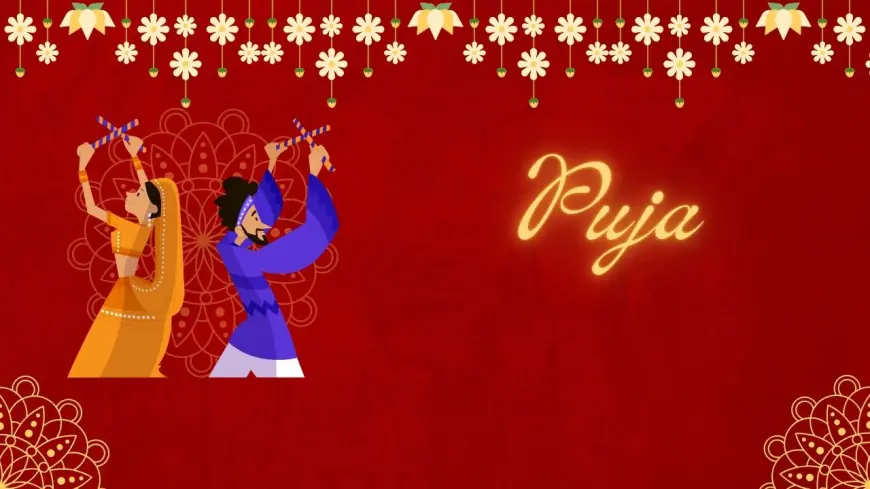What Is Online Puja?
Puja is an important part of Hindu worship, where people pray and offer things to gods to ask for blessings and feel closer to the spiritual world.

Puja is an important part of Hindu worship, where people pray and offer things to gods to ask for blessings and feel closer to the spiritual world. Usually, these ceremonies happen in temples, homes, or special places, and they bring people together to worship and follow religious traditions. But now, because of new technology, there's a different way to do puja—online puja. This modern method lets people perform rituals over the internet, often with help from trained priests, so they can take part in religious practices from their own homes, no matter where they are.
Online puja helps people stay connected to their faith, especially in today's busy world where going to a temple might be hard.
In this article, we look at what online puja is, why it's important, how it works, and the good and bad parts of this growing trend in religious life.
What Is Online Puja?
Online puja is when people perform Hindu religious rituals over the internet, often with help from priests. It lets people join puja ceremonies from anywhere, as long as they have an internet connection. During these online sessions, priests conduct the rituals live on video, and participants can watch, listen, and follow along from their homes or other places.
In regular pujas, a priest or spiritual leader does the ritual in person.
They say prayers, offer flowers, fruits, and incense, and ask for blessings from the gods. Online pujas do the same things but through digital platforms like Zoom, Skype, or YouTube. People can take part in the ceremony, ask for specific prayers, offer things, and get blessings, all while staying connected to their spiritual traditions.
The Rise of Online Puja: Technology Meets Tradition
The idea of online pooja started because of the internet, which connected people all over the world. As technology became more common, religious leaders and temples looked for ways to connect traditional worship with the needs of modern times. Online puja became popular in the early 2000s when Hindu temples and spiritual groups began offering virtual services to reach more people.
At first, online pujas were just recordings or live streams of temple ceremonies.
But as technology improved, these services became more advanced and personal. Today, many online puja platforms let people join in real-time, ask questions, or make their own prayer requests. This makes the experience more personal and meaningful for those who participate.
How Does Online Puja Work?
Taking part in an online puja is easy and can be tailored to fit personal needs. The process usually starts with the person choosing the type of puja they want and booking it via an online website. These websites offer many different puja options, ranging from everyday simple rituals to bigger ceremonies for special events like weddings, new home celebrations, or religious holidays.
After the booking is done, the puja is set for a time that works best for everyone involved, considering the time zones of all participants.
When the time comes, the person connects to the live session through a video call or a special streaming site. The priest then performs the puja, following the usual traditions, chants, and prayers that are part of that specific ceremony.
One of the best things about online puja is that it's very flexible.
People can take part as much as they like. They can pray and share their wishes in real time, give virtual offerings by making online donations, and even ask for special prayers or mantras. The priest, who is often at a temple or spiritual place, carries out the ritual just like if everyone were there in person, keeping the ceremony's meaning and importance the same.
Types of Online Pujas
Online pujas are available in many different types to suit various religious purposes and special events. Some of the most usual kinds are:
1. Home Pujas
Home pujas are special prayers done for individual families or specific people. They are usually held on important days like birthdays, anniversaries, or when someone reaches a big life moment. These pujas help families keep up with their religious traditions even if they can't go to a temple. A priest does the ceremony from a temple or a holy place, and the family members at home join in the way they can.
2. Festival Pujas
During big Hindu festivals like Diwali, Ganesh Chaturthi, or Navratri, online puja services let people join group rituals. These festivals usually have a lot of people taking part, with individuals from all around the world coming together to celebrate and pray virtually. Online puja helps people stay connected to the festive traditions and carry out the required rituals, even when they can't be physically present at the celebrations.
3. Sankalp Pujas
Sankalp pujas are done with a clear purpose, like a wish or a prayer. This purpose can be anything, such as asking for peace, success, removing problems, or improving one's health. People can tell the priest about their specific wish before the puja, which is carried out from a distance but still has a special meaning for them.
4. Shanti Pujas
Shanti pujas are special religious ceremonies done to find calm, balance, and blessings from the divine, especially when someone or their family is going through a tough time. Now, with the help of the internet, people can plan these pujas online to bring spiritual peace to themselves or to someone they care about. The online way makes it possible for people to join in the ceremony no matter where they are located.
5. Special Occasion Pujas
Online pujas are also a good choice for special events like weddings, housewarming ceremonies (Griha Pravesh), or other important occasions. During these events, the puja is arranged based on the particular needs of the occasion, and the online feature allows relatives and friends who are far away to take part in the celebration from their own place.
Benefits of Online Puja
Online pujas provide many advantages, which is why they are becoming a popular option for many people, especially in today's digital world.
Accessibility and Reach
One of the main benefits of doing online puja is that it's easy to access. People who live in places where there aren't many Hindu temples, or those who can't go to pujas because of old age, health issues, or difficulty traveling, can still take part in religious ceremonies. This helps break down distance barriers, so anyone, no matter where they are, can join a holy ritual.
Convenience and Flexibility
Online puja services offer a level of convenience that traditional in-person ceremonies can't match. People don't need to travel or change their plans to fit the schedule of a temple puja. They can choose to book pujas anytime that suits them and take part from the comfort of their own homes. The ability to pick any time and place makes online puja a great option for people with busy schedules or those living in different time zones.
Cost-Effectiveness
Traditional pujas can cost a lot, especially when you think about the money needed for traveling, paying the priest, and buying offerings. Online pujas are usually cheaper because you don't have to travel or buy anything. Also, the priest does the ritual from one place, which helps save money on extra costs.
Personalization
One of the best things about online puja is how much you can personalize it. People can ask for certain prayers, mantras, or gods to be included. Whether it's a special festival puja or a puja done with a personal wish in mind, online services offer many different options. This helps each person feel like the puja is made just for them.
Challenges of Online Puja
Even though online puja has many good points, it also has some drawbacks.
Spiritual Connection
For many people who are deeply spiritual, being physically present in a temple or at the priest's place makes their connection to the ritual much stronger. The visual, auditory, and sensory experiences of traditional prayers can't be fully felt through a screen, which might make the experience feel less real and more distant.
Technical Issues
Depending too much on technology can be a problem. If there's a bad internet connection or some technical issues, it can stop the live streaming of the puja and make the experience less enjoyable. Also, not everyone is used to using digital tools, especially older people, which might stop them from joining in completely.
Loss of Community Aspect
Traditional pujas usually bring people together as a community, with families and neighbors joining in to share the celebration. This feeling of togetherness is hard to recreate online, since online interactions are only through screens and not face-to-face.
Conclusion
Online puja shows how technology can help make traditional spiritual practices better and more modern. It lets people stay connected to their religion even if they can't go to a temple or do rituals in person. The ease of use, availability, and ability to customize online puja have made it a common choice for many, especially those living far away or with busy lives.
But it's also important to know that online puja, while convenient, might not give the same deep and meaningful experience as being in a temple.
The main goal of puja—connecting with the divine—stays the same, but the way people take part has changed to suit today's needs. Ultimately, what really matters is the sincerity and intention behind the puja, whether it's done in person or online.
What's Your Reaction?
 Like
0
Like
0
 Dislike
0
Dislike
0
 Love
0
Love
0
 Funny
0
Funny
0
 Angry
0
Angry
0
 Sad
0
Sad
0
 Wow
0
Wow
0



















































